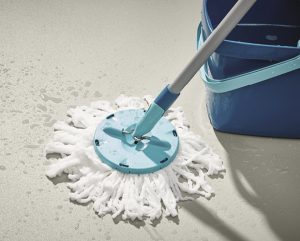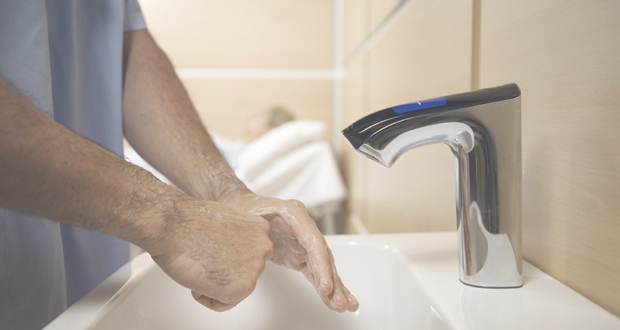COMMUNAL SPACES
Another major issue for FMs is to lessen the risk of contamination in communal spaces, including lifts, entrances/receptions and break-out areas. Broderick advises that the first step is to conduct a workplace risk assessment and then isolate off any communal areas that don’t need to be in use.
“Some businesses may be able to close lifts and ask people to use the stairs only. At the same time, a one-way system can be implemented to avoid people passing each other on the stairway.
“Of course, it may not be possible to close off every communal area so the next step is to identify high-risk areas and touchpoints and ensure that the cleaning regime pays extra attention to them. Certain staff can be allocated to tasks or equipment to reduce the risk of transmission. For example, one person on the FM team might take responsibility for switching the lights on and off each day. A simple action like that goes a long way to reducing transmission.”
Hatwell adds that automated doors are an obvious quick-win, although costly. A slightly simpler solution, although not viable for all doors, would be to add handsfree door openers.
The easiest way to remedy the potential problem of lifts is to take them out of service, but as this can pose DDA-related issues, it might be worthwhile restricting use of lifts to those with mobility issues.
He says: “At the very least, due to the confined spaces, operating a one-in, one-out policy would be beneficial. The provision of hand sanitisers stations throughout facilities is an obvious addition. Equally, again this applies everywhere, but every step should be taken to get individuals to follow best practise in terms of hand-washing and maintaining hygiene to avoid further cross-contamination.”
PROTECTING WORKERS
“If you are looking to use your own workforce to undertake the cleaning process”, says Jones, “ensure you follow the government guidance COVID-19: cleaning in non-healthcare settings(2). The guidance covers topics such as personal protective equipment, surfaces to focus on, what chemicals / substances to use and what to consider before placing used cleaning equipment in the waste.”
And when it comes to protecting their cleaning staff, cleaning firms need to ensure individual protection such as providing all members of staff with fabric face masks and gloves.
Says Ponniah: “We expect staff to wash their hands on arrival and if, for any reason, they need to remove gloves while working, to use sanitiser. Staff have also received clear instructions to adhere to the two-metre distancing rules at all times.
“Although the masks and gloves are primarily for our own staff, we have been working with clients to provide equipment for their employees, and offer ‘Welcome back’ kits of sanitiser and masks for staff returning to work. Cleaning firms should also be able to offer other products, such as door handle protection, footwear disinfection, and office sanitisers.”
HYGIENIC WASHROOMS
Special attention may be required in bathrooms to encourage hand hygiene and keep facilities sanitised. This is where developments in automation come into play.
“It’s vital that the role modern taps play in actively promoting hand hygiene and creating safe public spaces is recognised,” says Stuart Skinner, Senior Product Manager at washroom controls specialist Rada. “Taps with non-touch controls help manage the risk of cross-contamination. This functionality is well-established, particularly in hospitals and care facilities, but touchless interaction should be considered as an option for promoting hygienic facilities in every setting.
“Digitally connected and controlled taps unlock enhanced functionality. They offer gesture control so water temperatures can be easily adjusted without needing to touch the tap. These products also enable programmable flow times to help encourage the different handwashing processes for users, from the public to nurses and surgeons.
“Products must be easy to clean, with minimal joins and external components. Pathogens that cause bacterial or viral illnesses can live on hard surfaces for some time, posing a risk to users if not effectively removed. As we learn more about the possibilities this evolving technology can offer, manufacturers must work with facility managers to ensure users benefit from the latest innovations.”
 Broderick says that while bathrooms are certainly an important consideration when managing hygiene: “COVID-19 doesn’t discriminate between a bathroom, kitchen, desk or any other space, and so cleaning programmes shouldn’t either. In fact, FMs should consider installing hand sanitation stations around the office, especially near high-risk areas. This will enable occupants to manage their hygiene more efficiently, and reduce the strain on bathroom hygiene facilities.”
Broderick says that while bathrooms are certainly an important consideration when managing hygiene: “COVID-19 doesn’t discriminate between a bathroom, kitchen, desk or any other space, and so cleaning programmes shouldn’t either. In fact, FMs should consider installing hand sanitation stations around the office, especially near high-risk areas. This will enable occupants to manage their hygiene more efficiently, and reduce the strain on bathroom hygiene facilities.”
He also advises that cleaning audits need to be stepped up to ensure standards are maintained, with FMs creating audits and checklists to manage every single aspect of workplace risk, hygiene, two-metre social distancing and cleaning.
He concludes: “Even when people are fully aware of the threat COVID-19 poses, standards can drop and old habits picked back up. Ideally, daily visual inspections should be carried out and a more formal audit process introduced on a weekly basis to ensure that standards are being maintained, and to spot any holes or weaknesses in existing programmes.”





